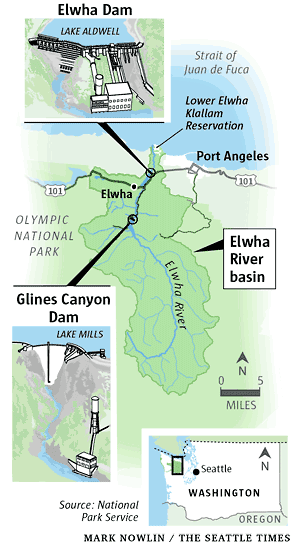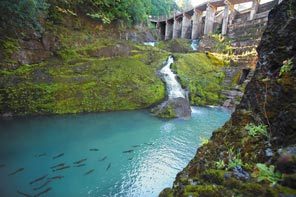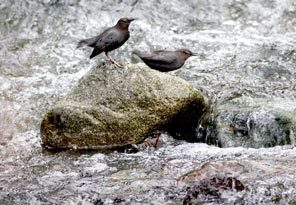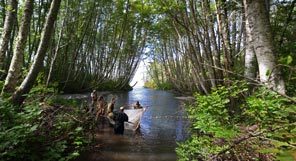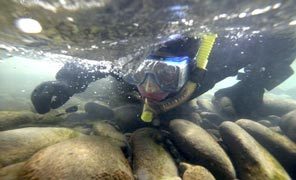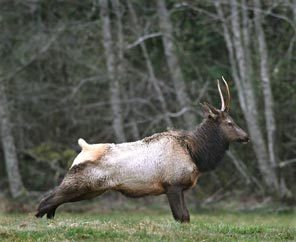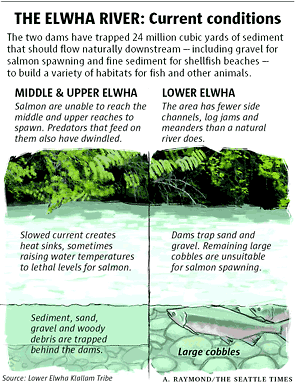Originally published Saturday, September 17, 2011 at 7:05 PM
Dams' removal promises unique chance to start over on a grand scale
The dismantling of two dams on the Elwha River is the largest dam-removal project anywhere in North America.
Seattle Times staff reporter
STEVE RINGMAN / THE SEATTLE TIMES
Every year, chinook salmon still come back to the pool below Elwha Dam, where they have been blocked from continuing their journey to spawning grounds upstream since construction began on the dam in 1910. Contractors are taking down Elwha and Glines Canyon dams in the largest dam-removal project ever.
STEVE RINGMAN / THE SEATTLE TIMES
A pair of nesting dippers pause very briefly while fishing underwater in an Elwha River tributary.
STEVE RINGMAN / THE SEATTLE TIMES
The team from the Northwest Fisheries Science Center uses nets to perform a fish count in a side channel of the Elwha River while documenting the river above and below the dams that will be removed next year.
STEVE RINGMAN / THE SEATTLE TIMES
Dam removal on the Elwha is a second chance for the entire watershed, reconnecting the mountains, the valley, the river and the sea to function together as an ecosystem. Today, in snorkel surveys of the river scientists find only resident fish such as rainbow trout above Elwha Dam.

THE DAMS
Story: An unprecedented restoration effort
THE HISTORY
Timeline: An Elwha River chronology
Video: Building dams, powering the economy
THE SALMON
Story: Will giant chinook salmon return?
Graphic: The five species of Elwha salmon
THE TRIBE
Story: The ancestors' prayers answered
Video: A talk with elder Adeline Smith
REVEGETATION
Story: Restoring a healthy watershed
THE SEDIMENT
Story: Biggest-ever sediment release
Graphic: Picturing 24 million cubic yards
CHAT REWIND
Behind the scenes of the Elwha special report
PROJECT HOME
![]()
It's too quiet. As a team of scientists unrolls sleeping bags to camp in the wilderness of the Elwha River's upper reaches, no slapping tails roil the water, during what should be the height of the summer salmon run. And in the morning, there are no eagles in the trees, no footprints of bears, no otter tracks on the sandy banks — and no salmon in the river.
The diaries of early explorers in the Olympics reveal a very different world: They could hardly sleep in the summer and fall if they unfurled bedrolls riverside during the salmon runs.
"I might as well have selected a camp in Barnum's Menagerie, so far as sleep was concerned," wrote Pvt. Harry Fisher, camped by the Queets River in 1890. "... great salmon threshed in the water all night long, in their efforts to ascend the stream. Wild animals which I could not see snapped the bushes in all directions, traveling up and down in search of fish. At every few yards was to be seen the remains of a fish where cougar, coon, otter, or eagle had made a meal."
Today, the only wild salmon in the middle and upper watershed of the Elwha are found in Indian elders' stories and explorers' journals. A keystone species, wild salmon, the animal that in every life stage helps feed this wilderness, from birds to bugs to salamanders to bears to cougar — yes, Barnum's menagerie — has been gone for a century. Shut out by two dams that block all fish passage five miles from the river's mouth.
But this month, contractors begin taking out Elwha and Glines Canyon dams, in the largest dam-removal project ever in North America. It's a grand experiment that will unleash 24 million cubic yards of sediment — the largest controlled release of sediment ever — and require an unprecedented revegetation effort. If it works, within a generation, the Elwha watershed will once again be noisy with life — and the river alive with salmon.
They still try to get upriver. Every fall, you can see them, knocking on the locked door to their house: Elwha Dam, blocking all passage to some 70 miles of habitat. They line up in a row, facing the dam as if to stare it down, urged on by a homing instinct still embedded in their genes.
Dam removal on the Elwha has been passionately contested for more than a generation. And now that it has started, no one can say exactly how this taxpayer-funded, $325 million roll of the dice will all come out.
But with more than 80 percent of the area above the lower dam permanently protected within Olympic National Park, the Elwha represents a unique restoration opportunity. Notes John McMillan, a scientist with the National Oceanic and Atmospheric Administration working on the Elwha, "We don't have any examples where we've taken the foot off the neck, where so much of the watershed is in pristine condition."
River is the heart of a vast ecosystem
The Elwha is many rivers. It flows through a landscape that alternates between tight, solid rock canyons and broad, flat valleys. It moves not just in its main channel, but in rippling, green glides that twine around logjams and into quiet, spring-fed side channels.
Born in the southern Bailey Range of the Olympics, the Elwha is the center of a wild ecosystem, stretching 45 miles from the glaciers of Mount Olympus in the northwest quadrant of Washington state to the Strait of Juan de Fuca, which divides the U.S. and Canada. With eight major tributaries, more than 115 miles of the Elwha's silvery fingers reach into a 321- square-mile watershed.
Visible even from downtown Seattle, the Olympic Mountains that crown the Elwha River are ghosted with mists and clouds, and gleam with snow.
A century ago, there was no month of the year that didn't see a run of fish migrating upstream, spawning, maturing, or juveniles slipping out to sea: sockeye, pinks, chum, summer and winter steelhead, coho, spring and fall chinook, cutthroat, bull trout, lamprey, eulachon, rainbow trout.
Today, no oceangoing fish live above Elwha Dam.
Preparation: Even the rocks got microchips
The dams will be taken out gradually, over the course of up to three years. Bit by bit, the river and millions of cubic yards of sediment will be released from behind the dams, and Lake Aldwell and Lake Mills will disappear, exposing about 800 acres of land.
For at least a decade, scientists have been getting ready for this moment, documenting the baseline condition of the Elwha watershed. You name it, they've done it, in a nonstop rodeo of fin clipping, wire tagging, electroshocking, measuring, sexing, anesthetizing, tissue sampling, stomach pumping, beach seining, snorkel surveying, sonar imaging, trapping and tagging. And still more tagging. Tagging everything: elk, bear, river otters, songbirds and more fish than you can imagine. Even rocks, with little microchips plugged inside, to see how long it takes them to tumble down the riverbed or move on the beach.
Some of the techniques are rudimentary, and so are the tools: basically, whatever can be lugged into the backcountry. Rulers, 5-gallon plastic buckets, Tupperware, waterproof notebooks, pencils, sieves, sample bottles, fishing rods and drift nets. But the mission is ambitious. Scientists have been studying this river from its headwaters to mouth, to document its baseline condition. It's work they hope to continue, to determine the unfolding effects of dam removal.
Sealed up tight in dry suits before making camp on the river one evening in July 2010, NOAA employees Keith Denton and Daniel Hernandez worked side channels of the Elwha, doing a snorkel survey of everything they could find swimming in the water. Dreamy where the flow was deep, it was work that quickly turned to a belly crawl, with Denton rolling on his side and taking his mouthpiece out to call out to Hernandez every fish he found, so Hernandez could log the tally from the banks. For the snorkeler in the team — they took turns — it was inch-by-inch work, poking head first under root wads, and probing back eddies barely deep enough to float in.
John McMillan, a biologist with NOAA fisheries, has snorkeled nearly every reach of this river, surveying fish populations. It's a steep, fast, dangerous mountain river that leaves little room for mistakes. "Kayakers love them," McMillan said of the Olympic Peninsula's mountain rivers. "Snorkelers fear them."
Yet these snorkel surveys have given researchers a rare look at the Elwha's fish, a peek into the world under the surface. Up here in the backcountry, McMillan felt he was getting face time with rainbow trout that had never seen people. "They are friendly. They look at you unafraid, as if to say, 'You are not an otter,' " McMillan said.
Jump-starting the recovery
The National Park Service will oversee the restoration effort, which will involve more than nature's handiwork. The park service intends to airlift fish into the backcountry to jump-start recolonization. An unprecedented revegetation effort is intended to fend off an army of invasive weeds in the mud flats. A massive new hatchery for the Lower Elwha Klallam Tribe will pump fish into the river, including non-native steelhead. That controversial political decision was made in part to get fishermen back on the water faster and satisfy treaty rights, though scientists say it poses an unjustified risk to fragile native runs.
But nature will do a lion's share of the restoration work: More than three-quarters of the Elwha watershed was never developed and is permanently protected within Olympic National Park. The Elwha is expected to gradually regain much of its natural form and function, roughhousing across its flood plain, muscling cobble and fine sediment along, and building great jams of logs.
The river will be the workhorse that redistributes some 24 million cubic yards of sediment impounded behind the dams, transporting it throughout its run all the way into the Strait of Juan de Fuca, and helping to restore the beaches at the river's mouth.
And as the salmon recolonize the river and its tributaries, they are expected to be the vectors of something much bigger than river restoration. With the nutrients in their bodies, they can help nurture recovery of the entire watershed, bringing an annual bounty back to the land from the great pastures of the sea.
Swimming all the way to the mountains, they'll spawn and die, then decompose, sending nitrogen and other nutrients in their bodies derived from the sea back to the land. Animals also feed on both juvenile and adult salmon, lugging salmon carcasses deeper into the woods. That feeds the land and the trees, and so does the animals' manure.
High hopes, high stakes
To be sure, the Elwha will never be like it was. Development in the lower river, levees and armoring of bluffs along the beach mean the river and near shore will never regain their full function. Hatchery fish will continue to influence fish populations.
McMillan doesn't doubt the fish will boom back. He was 9 years old when Mount St. Helens erupted, plugging the Toutle River with ash. Yet the salmon survived that volcanic blast, recolonizing the river, just as they recolonized the entire Puget Sound after the retreat of the glaciers 10,000 years ago.
To him, by comparison, two dams don't seem like much to get over: "Nature puts itself back together with the parts it has."
The stakes are high. "Is anyone prepared for the project not to work?" asked Gordon Grant of the U.S. Geological Survey, during a 2010 tour of the Elwha by scientists from around the country. "If we are going to claim success, we have to be prepared to admit failure, too. I'm thinking about it from the taxpayer's perspective." Considering the cost, the uncertainty and the destruction of two hydropower dams making carbon-free electricity, the project has its critics, Grant said. "I give talks abroad, and they think we are crazy."
But George Pess, a NOAA fisheries biologist leading a team of scientists gathering baseline data on the Elwha, said nature is a reliable force. "Ecology happens. Natural systems know how to function. And they do, if you get out of their way."








